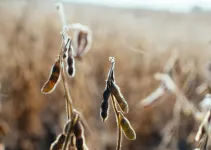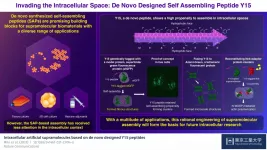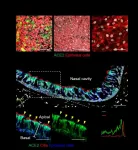Cleaner air has boosted US corn and soybean yields, Stanford-led research shows
2021-07-01
(Press-News.org) A key factor in America's prodigious agricultural output turns out to be something farmers can do little to control: clean air. A new Stanford-led study estimates pollution reductions between 1999 and 2019 contributed to about 20 percent of the increase in corn and soybean yield gains during that period - an amount worth about $5 billion per year.
The analysis, published this week in Environmental Research Letters, reveals that four key air pollutants are particularly damaging to crops, and accounted for an average loss of about 5 percent of corn and soybean production over the study period. The findings could help inform technology and policy changes to benefit American agriculture, and underscore the value of reducing air pollution in other parts of the world.
"Air pollution impacts have been hard to measure in the past, because two farmers even just 10 miles apart can be facing very different air quality. By using satellites, we were able to measure very fine scale patterns and unpack the role of different pollutants," said study lead author David Lobell, the Gloria and Richard Kushel Director of the Center on Food Security and the Environment.
The research highlights the considerable power of satellites to illuminate pollution impacts at a scale not possible otherwise. That power could be of even greater value in countries with less access to air monitors and yield data.
Reading the air
Scientists have long known that air pollution is toxic to plant life in high doses, but not how much farmers' yields are actually hurt at current levels. The impact of pollution on agriculture overall, as well as the effects of individual pollutants, has also remained unknown.
Focusing on a nine-state region (Illinois, Indiana, Iowa, Michigan, Minnesota, Missouri, Ohio, South Dakota and Wisconsin) that produces roughly two-thirds of national maize and soybean output, Lobell and study co-author Jennifer Burney, an associate professor of environmental science at the University of California, San Diego, set out to measure the impact on crop yields of ozone, particulate matter, nitrogen dioxide and sulfur dioxide.
Ozone is the result of heat and sunlight-driven chemical reactions between nitrogen and hydrocarbons, such as those found in car exhaust. Particulate matter refers to large particles of dust, dirt, soot or smoke. Nitrogen dioxide and sulfur dioxide are gases released into the atmosphere primarily through the burning of fossil fuels at power plants and other industrial facilities.
"This has been a tricky problem to untangle because historically our measurements of different types of air pollutants and our measurements of agricultural yields haven't really overlapped spatially at the necessary resolution," explained Burney. "With the new high spatial resolution data, we could look at crop yields near both pollution monitors and known pollutant emissions sources. That revealed evidence of different magnitudes of negative impacts caused by different pollutants."
Lobell and Burney extended their analysis back to 1990, when Congress passed Clean Air Act amendments that resulted in significant air quality improvements across the country. The researchers looked through air pollution data from hundreds of monitoring stations around the region, federal data on power plant emissions, satellite-based observations of nitrogen dioxide around those power plants, crop yield data from federal surveys and satellite imagery, as well as weather data to account for growing season conditions known to explain crop yield variations.
Surprising findings
What Lobell and Burney discovered surprised them. Among their findings: negative effects of each of the four pollutants on corn and soybean yields, and a clear yield increase the farther away from power plants - particularly coal-burning facilities - crops were grown. The unique spatial patterns of each pollutant allowed them to disentangle the effect of each pollutant in a way that past studies could not.
The researchers estimated that total yield losses from the four pollutants averaged 5.8 percent for maize and 3.8 percent for soybean over the past two decades. Those losses declined over time as the air grew cleaner. In fact, the reduction in air pollution contributed to an estimated 4 percent growth in corn yields and 3 percent growth in soybean yields - increases that equal 19 percent of corn's overall yield gains during the timeframe and 23 percent of soybeans' overall yield gains.
"We already know that the Clean Air Act resulted in trillions of dollars of benefits in terms of human health, so I think of these billions in agricultural benefits as icing on the cake," Lobell said. "But even if it's a small part of the benefits of clear air, it has been a pretty big part of our ability to continue pushing agricultural productivity higher."
INFORMATION:
Lobell is also a professor of Earth system science in Stanford's School of Earth, Energy & Environmental Sciences, the William Wrigley Senior Fellow at the Stanford Woods Institute for the Environment and a senior fellow at the Freeman Spogli Institute for International Studies and the Stanford Institute for Economic Policy Research. Burney also holds the Marshall Saunders Chancellor's Endowed Chair in Global Climate Policy and Research at UC San Diego and is a research affiliate at UC San Diego's Policy Design and Evaluation Laboratory, a fellow at the Stanford Center on Food Security and the Environment, and head of the Science Policy Fellows Program at UC San Diego.
This research was funded by NASA and the National Science Foundation.
[Attachments] See images for this press release:

ELSE PRESS RELEASES FROM THIS DATE:
2021-07-01
The number of people who live past the age of 100 has been on the rise for decades, up to nearly half a million people worldwide.
There are, however, far fewer "supercentenarians," people who live to age 110 or even longer. The oldest living person, Jeanne Calment of France, was 122 when she died in 1997; currently, the world's oldest person is 118-year-old Kane Tanaka of Japan.
Such extreme longevity, according to new research by the University of Washington, likely will continue to rise slowly by the end of this century, and estimates show that a lifespan of 125 years, or even 130 years, is possible.
"People are fascinated by the extremes of humanity, whether it's going to the moon, how fast someone can run in the Olympics, or even how long someone ...
2021-07-01
In Canada, low-income hospital patients under palliative care are less likely to receive medical assistance in dying compared to those who are high income, according to a study published in British Medical Journal Open (BMJ Open).
Medical assistance in dying (MAID) is legal and free under Medicare, Canada's universal health care system. Patients with low socioeconomic status (SES), however, generally tend to experience less access to medical care compared to their high SES counterparts.
Eldar Shafir, professor of psychology and public affairs at the Princeton School of Public and International Affairs, along ...
2021-07-01
Imaging spectroscopy can help predict water stress in wild blueberry barrens, according to a University of Maine-led study.
The technology involves measuring the light reflected off of objects depicted in images captured by drones, satellites and other remote sensing technology to classify and gather pertinent information about the objects. According to researchers, it can precisely measure light across dozens, if not hundreds, of bands of colors. The reflectance spectra can depict nutrient levels, chlorophyll content and other indicators of health for various crops, according to researchers.
Scientists from UMaine, the Schoodic Institute and Wyman's, one of the world's largest purveyors of wild blueberries and ...
2021-07-01
More than 80 percent of people around the world consider themselves to be religious or spiritual. But research on the neuroscience of spirituality and religiosity has been sparse. Previous studies have used functional neuroimaging, in which an individual undergoes a brain scan while performing a task to see what areas of the brain light up. But these correlative studies have given a spotty and often inconsistent picture of spirituality. A new study led by investigators at Brigham and Women's Hospital takes a new approach to mapping spirituality and religiosity and finds that spiritual acceptance can be localized to a specific brain circuit. This brain circuit is centered in the periaqueductal gray (PAG), a brainstem region that has been implicated ...
2021-07-01
Over the last two decades, biomaterials research has made significant progress, transitioning from traditional biomaterials to biomaterials with controlled structure and dynamic functionality. A number of building blocks have been explored for developing biomaterials by self-assembly, but SAPs have garnered special attention due to their tunability and potential use in various applications such as tissue engineering, wound healing, and vaccinations. Despite these benefits, the SAP-based approach is less explored in the intracellular context.
Fortunately, a team of scientists from the Tokyo Institute of Technology (Tokyo Tech), led by Assistant Prof. Takayuki Miki, have reported a de novo peptide, Y15, that ...
2021-07-01
Boulder, Colo., USA: The Geological Society of America regularly publishes
articles online ahead of print. GSA Bulletin topics include
multiple articles about the dynamics of China and Tibet; the end-Permian
terrestrial extinction paradigm in South Africa; prehistoric lava flows
from the urban district of Catania (Etna volcano, Italy); the debated
origins of granite, and "a tale of two Tweefonteins." You can find these
articles at
https://bulletin.geoscienceworld.org/content/early/recent
.
Authigenic berthierine and incipient chloritization in shallowly ...
2021-07-01
Most babies born prematurely or with health problems are quickly whisked away to the Neonatal Intensive Care Unit (NICU) where they might require assisted heating devices to regulate their temperature. A University of Houston College of Nursing researcher is reporting that the traditional use of cloth blankets and towels during peripherally inserted central catheter (PICC) placement may hinder heat transfer from the assisted heating mechanisms, increasing the risk for neonatal hypothermia. In Advances in Neonatal Care, Huong (Kelle) Phan, clinical assistant professor, reports that a plastic drape lowers the incidence of hypothermia.
"The use of the plastic drape is a quality improvement to reduce the hypothermia rate in very low birth-weight ...
2021-07-01
WILMINGTON, Del. (June 29, 2021) - A new report finds that 509,025 (9.17%) public high school students in 24 states experienced homelessness in spring 2019 -- three times the number recognized by the states' education agencies. This under-recognition creates gaps in funding and services needed by this vulnerable population.
Researchers from Nemours Children's Health and the University of Pennsylvania analyzed data from the Centers for Disease Control and Prevention (CDC) for public schools across 24 states and 12 school districts. During spring 2019, more than 9% of public high school students experienced homelessness during a 30-day period in the 24 states. The rate was even higher in the 12 school ...
2021-07-01
New research published today in the journal Blood Advances finds that certain factors, such as a history of severe pain episodes and coexisting organ conditions, increase the risk of severe COVID-19 illness, including hospitalization, in individuals living with sickle cell disease (SCD). According to researchers, the study results underscore the need for COVID-19 risk reduction strategies and vaccination for this medically vulnerable population.
SCD is the most common inherited red blood cell disorder in the United States, affecting an estimated 100,000 people. According to the Centers for Disease Control and Prevention, SCD affects one out of ...
2021-07-01
Understanding how viral infection occurs can provide important clues for researchers to develop strategies to prevent viral transmission and develop effective therapeutic agents and vaccines. SARS-CoV-2, the causative agent of COVID-19, enters the host cells through interaction between the virus's spike protein and the extracellular receptor binding domain of ACE2. The viral entry into the cells is completed by various proteases, which allow the viral and cell membranes to fuse together. While it is known that the upper respiratory tract becomes compromised in the early infection, the exact types of the cells that the virus infects at the earliest stage have not yet been identified.
Led by Director ...
LAST 30 PRESS RELEASES:
[Press-News.org] Cleaner air has boosted US corn and soybean yields, Stanford-led research shows




